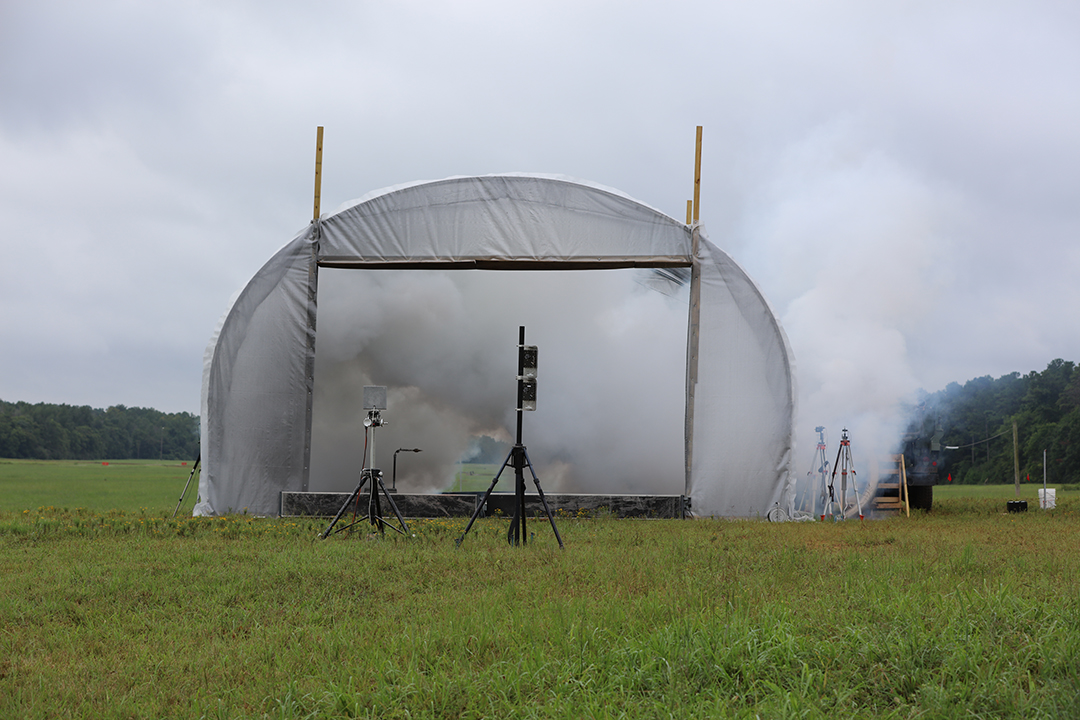// NEWS RELEASE
ECBC Researchers Work to Develop the Next Generation of Battlefield Obscurants
CCDC Chemical Biological Center Public Affairs | November 27th, 2017
ECBC Researchers Work to Develop the Next Generation of Battlefield Obscurants
DEVCOM CBC Public AffairsNovember 27th, 2017

An ECBC research team tested three types of obscurants inside a greenhouse tent at the Redstone Test Center in August to model their effectiveness in protecting armored forces.
Gone are the days when a military unit could make a quick battlefield maneuver under the cover of mere smoke. Today, with the advent of thermal imaging and infrared sensors, battlefield obscurants must be able to go well beyond the visible light spectrum and foil an entire range of remote sensors in order to defeat the anti-armor missiles that those sensors guide.
For the Edgewood Chemical Biological Center (ECBC) researchers who develop and field smoke and obscurants, this means turning to something other than smoke entirely – nanoparticles. This involves finding the right shapes, varying from flakes, to rods to discs, and finding just the right sizes for each, plus the blend of shapes to provide maximum obscuration. In addition to optimizing obscuration performance, the final recipe that becomes the next-generation obscurant must also stay suspended in air for a long time, have low toxicity for the friendly Soldiers near it, and not be prohibitively expensive to produce.
“Finding just that right mix of shapes and sizes, and with just the right density, is a challenge because we are dealing with a spectrum that ranges from visual light to near infrared to shortwave, midwave and longwave IR,” said Larry Bickford, chief of ECBC’s Smoke and Target Defeat Branch. “Different shapes work better at different points in the spectrum, and there’s also the need to disseminate these particles out into an aerosol cloud rather than sticking together.”
The term for keeping the particles from sticking together is “de-agglomeration.” This is an entire area of study of its own with solutions ranging from modulating the strength of the airflow that releases the particles, to adding turbulence to the flow, to treating the particles with a special de-agglomeration coating. And, as if obscuration science could not get any more complicated, there is the issue of achieving continuous conductivity over the major dimension of the particles. “A good flow of electrons running along the length of the particles works well to block IR sensors,” said Bickford.
The ECBC research team’s work was put to the test in August at the Redstone Test Center (RTC) in Huntsville, Alabama. They released three different types of obscurants into an enormous tent-style greenhouse and challenged them with visual and IR range sensors that an enemy force could bring to bear. The team is using feedback from sensors to determine the effectiveness of each obscurant and the optimal concentration of each.
In attendance at Redstone were three Army research laboratories, two intelligence agencies, a university research team, and an industry research team. “The test proved very successful and we finished it ahead of schedule,” said Robert Carestia, the team’s project manager. “Next we are going to thoroughly analyze the data we obtained, model the performance of each obscurant, and share the results with our Army and agency partners.”
The team’s obscurants are also used by the Army researchers who develop remote sensors for U.S. forces. “There’s no better way for those researchers to test their remote sensors against potential enemy obscurants than to use ours,” said Bickford. “Not only are they readily available to them, but they are unlikely to run up against anything more sophisticated than what we have already developed.”
The future of this research effort extends beyond perfecting the particles themselves. “As the technology improves, U.S. forces will improve the delivery systems. They will be released from unmanned ground and aerial vehicles,” said Bickford. “And we are going to have new challenges, like determining how rotor wash from drones and the trailing turbulence of fast-moving ground vehicles affects the dispersion of the particles.” ECBC has been at the forefront of smoke and obscurants research since World War I, and the Center’s continuing research in the field is helping to ensure that the warfighters of tomorrow continue to benefit from cutting edge concealment technologies.
The U.S. Army Combat Capabilities Development Command (DEVCOM) leads in the discovery, development and delivery of technology-based capabilities to enable Soldiers to win our nation’s wars and come home safely. DEVCOM is a major subordinate command of the U.S. Army Futures Command. The DEVCOM Chemical Biological Center is the Army’s principal research and development center for chemical and biological defense technology, engineering and field operations. The DEVCOM Chemical Biological Center is headquartered at Aberdeen Proving Ground, Maryland.
